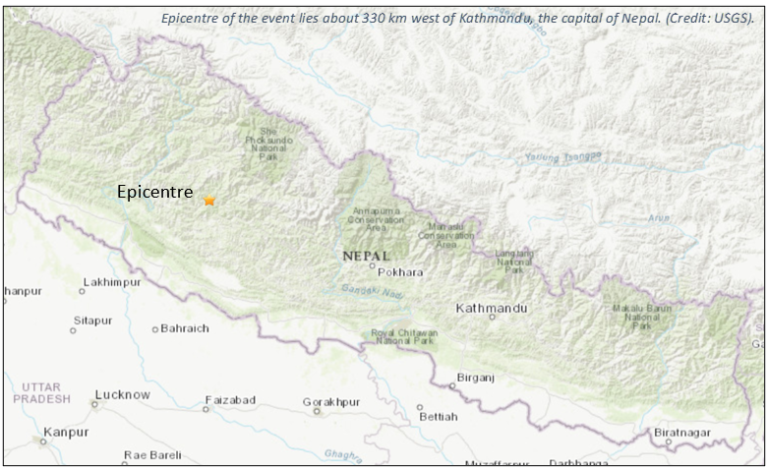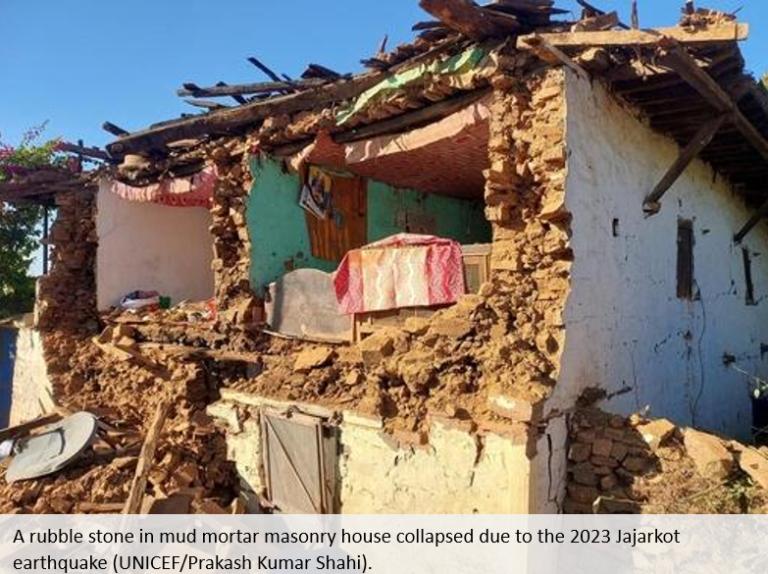Jajarkot, Nepal ML6.4 earthquake
13 November 2023
On 3rd November at 23:47 NPT, a powerful ML6.4 earthquake struck Nepal with its epicentre in Jajarkot, a remote hilly district, nearly 330 km WEST of Kathmandu. More than 150 deaths have been reported and several hundred injured due to the direct effect of the earthquake.

The major cause of deaths and injuries is the collapse of weak building structures, as thousands of houses were destroyed (see Figure below). The earthquake is the deadliest event since the 2015 Gorkha earthquake and was felt all over the country and as far as in North India.

According to the District Education Office of Jajarkot, 213 school buildings have been damaged in Jajarkot alone. 91 school facilities have been severely affected while other 122 schools have suffered partial damage hampering teaching learning activities. The number of affected schools and buildings is higher as other nearby districts are also affected. Moreover, as per UNICEF, children account for nearly half of the death or injured due to the event.
Most of the damaged houses and schools are poorly built masonry structures (mostly rubble stone in mud mortar), similar to the situation we observed during the 2015 Gorkha earthquake. Although the 2015 event clearly showed that poorly constructed masonry houses or school buildings throughout the country needed to be prioritised for retrofit intervention, this has not yet been rolled out and implemented with the urgency required. Until and unless we learn lessons from past events, we can not engineer our buildings for improved seismic resilience.
After the 2015 event, researchers from UNESCO Chair in DRR-RE at UCL EPICentre studied such masonry building typologies (both houses and schools) using field surveys and advanced modelling and analysis techniques to reliably predict their seismic capacity and behaviour. Moreover, appropriate and effective seismic retrofit options were also studied. The results of these research studies were communicated frequently to the concerned authorities in Nepal. To deliver a successful campaign of retrofit and mitigation of damage before the next earthquake all players need to come together: better awareness of the people occupying these buildings, social acceptance, motivation, political support, economic conditions and local initiatives promoted by the government and private sector.
All stakeholders should join forces and take urgent actions in promoting and implementing effective retrofitting of the existing weak buildings such as the masonry houses and schools, thousands of which are still present in the hilly regions of Nepal and beyond in the Himalayan countries, and cannot be replaced in a timely manner. Considering the highly active seismicity in the region, this is the only way forward in order to improve seismic resilience and minimise losses of life in future events.
Relevant publications:
Adhikari, R.K. and D’Ayala, D., 2020. 2015 Nepal earthquake: seismic performance and post-earthquake reconstruction of stone in mud mortar masonry buildings. Bulletin of earthquake engineering, 18, pp.3863-3896.
Adhikari, R., D'Ayala, D. and Norris, A., 2020, September. Seismic performance evaluation of the existing and retrofitted stone masonry houses in Nepal. 17th World Conference on Earthquake Engineering.
D'Ayala, D., Galasso, C., Nassirpour, A., Adhikari, R.K., Yamin, L., Fernandez, R., Lo, D., Garciano, L. and Oreta, A., 2020. Resilient communities through safer schools. International journal of disaster risk reduction, 45, p.101446.
Adhikari, R.K., Parammal Vatteri, A. and D’Ayala, D., 2023. Seismic Performance Assessment of Low-Rise Unreinforced and Confined Brick Masonry School Buildings Using the Applied Element Method. Buildings, 13(1), p.159.
Adhikari, R.K., 2021. A Methodological Framework for Seismic Vulnerability Assessment of Masonry School Buildings: Application to Nepal (Doctoral dissertation, UCL (University College London)).
 Close
Close

